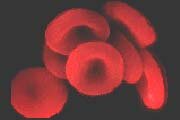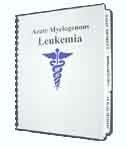 |
||
| HOME | ||
 |
||
| Acute Myelogenous Leukemia (AML) |
||
 |
||
| Other Leukemia Types (ALL / CLL / CML / HCL) |
||
 |
||
| Myelodysplastic Syndrome | ||
 |
||
| Symptoms and Diagnosis | ||
 |
||
| Leukemia Treatment Options | ||
 |
||
| " Chemotherapy | ||
 |
||
| " Blood Stem Cell Transplants | ||
 |
||
| " Radiation and Surgery | ||
 |
||
| " Chemo Side Effects | ||
 |
||
| " Clinical Trials Info | ||
 |
||
| " Coping with Leukemia | ||
 |
||
| " What to Ask Your Doctor | ||
 |
||
| Financial Assistance | ||
 |
||
| At Risk Jobs/Exposure | ||
 |
||
| Leukemia Resources | ||
 |
||
| Survivor's Story | ||
 |
||
| Leukemia News | ||
 |
||
|
Search for information:
|
||

|
Leukemia Cancer News - Return to Menu New Target Found for Treating Acute Myeloid Leukemia: Presented at ASH By Mike Fillon ATLANTA, GA -- December 14, 2005 -- New research shows that a novel antibody could target the specific cells that lead to acute myeloid leukemia (AML). Results of the study were presented here December 11th at the 47th Annual Meeting of the American Society of Hematology (ASH). James N. George, MD, Professor of Medicine, University of Oklahoma Health Sciences Center, Oklahoma City, Oklahoma, United States, and President of ASH said the study "provides important new insights for further improving our ability to treat this once inevitably fatal disease." AML results when maverick stem cells in the bone marrow produce unchecked numbers of immature white blood cells, called myeloid cells. Nearly 12,000 new cases of AML have been diagnosed in the United States this year. Senior study author Gerrit Jan Schuurhuis, PhD, Associate Professor, VU University Medical Center, Amsterdam, The Netherlands, noted that different kinds of stem cells can be distinguished by different molecular markers on their surface. Stem cells characterized by the presence of the CD34 marker and the absence of the CD38 marker (CD34+CD38-) appear to be the initiation point for AML. Sometimes these cells can survive even under intense chemotherapy, and, when found in high frequency after treatment, correlate to a return of the cancer and high mortality. However, as stem cells are rare, they are hard to find. Previous research indicated that myeloid cells have a marker on their surface called CLL-1 that could be detected by a particular protein called anti-CLL-1 antibody. To see if this antibody could also detect hidden bastions of the CD34+CD38- stem cells in AML patients in remission, Dr. George's team. In the study, the antibody detected CD34+CD38- stem cells in 77 out of 89 AML patients at the time of diagnosis. CLL-1 expression in CD34+CD38-cells of control bone marrows was virtually absent. For those AML patients in remission who were CLL-1 positive, the ratio of CLL-1 positive AML stem cells to normal (CLL-1 negative) stem cells correlated to the probability of relapse. Therefore, patients in remission who are found to have dormant CD34+CD38- cells in their marrow are ideal candidates for antibody therapy. Dr. Schuurhuis said the data provides strong evidence that a large CD34+CD38- population at diagnosis reflects a higher percentage of chemotherapy-resistant cells, which, in remission, will lead to the outgrowth of minimal residual disease, thereby affecting clinical outcome. "The reliability of this antibody to detect and quantify the particular stem cells that foreshadow a poor prognosis for AML patients in remission means that scientists may now have the ability to hone in on these specific cells and target them for treatment," Dr. Schuurhuis said.
ASH: Oral Targeted Agent Boosts Remissions in Poor-Prognosis AML Inform patients who ask that this is a phase II study of an oral drug that targets acute myeloid leukemia with one of two mutations in the gene for the receptor tyrosine kinase FTL3. About 25% to 30% of people with AML have this mutation, which is associated with greater likelihood of relapse and shorter survival. This study was published as an abstract and presented orally at a conference. These data and conclusions should be considered to be preliminary as they have not yet been reviewed and published in a peer-reviewed publication Review The drug, labeled CEP-701, or lestaurtinib, inhibits the receptor tyrosine kinase FLT3. Nearly a third of patients with AML have a mutation in the gene that encodes for FLT3 that is associated with a greater risk of relapse and reduced survival. In the ongoing phase II trial, 10 of 22 patients who received chemotherapy followed by lestaurtinib achieved complete remissions, compared with six of 22 on chemotherapy alone, reported oncologist Mark Levis, M.D., Ph.D., of Johns Hopkins and colleagues at the American Society of Hematology meeting here. There is also evidence to suggest that laboratory studies can help clinicians to predict which patients could most benefit from the therapy, the investigators said. "Therapies that target FLT3 and other important genetic mutations may allow us to better manage diseases with a poor prognosis," Dr. Levis said. "The ability to correlate molecular activity with clinical response in this patient population is an important step in demonstrating that CEP-701 acts as a targeted biotherapy." In the study, patients with AML in first relapse who have one of two FLT3-activating mutations are being randomly assigned to chemotherapy alone or the same regimen followed by lestaurtinib. The chemotherapy regimen patients received was dependent on duration of the first remission. Patients whose remissions lasted one to six months received the MEC regimen (consisting of mitoxantrone, etoposide, and cytarabine), while those whose remissions lasted from six months up to two years were treated with the HiDAC (high-dose cytarabine) regimen. Both regimens were given for five days. Patients who were randomized to also receive lestaurtinib were given the drug in an oral dose of 80 mg twice a day starting two days after the end of chemotherapy and continuing for up to 113 days. The primary study endpoint was complete remission occurring within 42 days of study entry. As of Dec. 12, 2005, 22 patients were enrolled in each study arm. Although the data are preliminary, they appear to show benefit to the chemotherapy-lestaurtinib combination, with 10 of 22 patients (45%) achieving complete remission compared with six of 22 (27%) of those on chemotherapy alone. In addition, the investigators are looking at whether sensitivity of leukemia cells at baseline to lestaurtinib can be predictive of clinical response down the road. To that end, prior to chemotherapy they extracted leukemic cells from the patients who were scheduled to receive lestaurtinib, and assessed their sensitivity to the drug in vitro. They also drew plasma samples at treatment days 15 and 42 to determine FLT3-inhibitory activity. Evidence shows that all patients whose cells at baseline were susceptible to lestaurtinib and who had inhibition of FLT3 activity > 85% also have had a significant clinical response. In contrast, patients with low-baseline sensitivity to lestaurtinib or low FLT3-inhibitory activity (low drug plasma levels) had low rates of clinical response. Early data on safety indicate that the oral agent is generally well tolerated, resulting in a "modest" increase in gastrointestinal events such as nausea and dyspepsia reported, resulting in a small number of study withdrawals (number not given). Primary source: American Society of Hematology 47th Annual Meeting |
|
|


